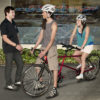
Since the birth of Santana Cycles in 1976 we have worked with one goal: to provide the best riding tandems on the planet. Our innovations revolutionized the way tandems ride and helped make an already fun activity more safe and enjoyable. Before the first frame was built Santana worked with a tubing manufacturer to draw a double-butted tubeset expressly for use in tandems. Extensive testing and fourteen ever-better prototypes preceded Santana’s creation of the first modern tandem—a bike simultaneously faster and more reliable than the best racing singles.
Seeking to learn more about frame flex peculiar to tandems, in 1982 Santana staffers built a tandem version of the “Tarantula” test jig built by Gary Klein for Bicycling Magazine. The Direct Lateral frame design came into being as the Santana design team used this beast to scientifically create a lighter, stiffer and more comfortable tandem. Our Direct Lateral, initially criticized by all other builders, has since become the industry-wide standard.
Before fame and fortune found Salsa’s Ross Shaefer, he worked for Santana and helped design the world’s first production mountain tandems. Turning to Columbus of Italy, Santana helped the Italian tubing giant develop a lighter-weight tubeset than had previously been used in tandems. The 9/6/9 butted tubes Columbus drew in 1983 are thinner than what many of Santana’s competitors use today.
The 1990s saw a flurry of innovations as Santana collaborated with Columbus (NivaCrom in ’90), Easton (double-butted aluminum in ’93) and Ancotech (double-butted titanium in ’96) to create tandem-specific tubesets worthy of the industry leader. Dissatisfied with the performance of available disc brakes, in 1997 we worked with the Italian manufacturer Formula to develop a tandem-specific hydraulic disc brake and the industry’s first remote master cylinder, thereby allowing owners of the world’s finest road tandems to combine hydraulic braking with integrated brake/shift levers.
By 2000 Santana had joined forces with Shimano and various composites experts to engineer aerodynamic tandem-specific 16-spoke wheels and carbon fiber forks which, taken together, reduce wind resistance while shedding three pounds of weight. Then, to produce lighter tandems that stow into a suitcase and fly for free, we teamed with S&S to create aluminum couplers. “Stowaway” models built with these exclusive pieces are 4-5 pounds lighter than the S&S tandems built by others.
In 2003 Santana introduced yet another revolution in cycling performance. Santana’s new Beyond tandem is built with IsoGrid™—the world’s first weldable carbon fiber tubing.
Today, Santana produces the lightest-ever tandems built with steel (using Columbus’ new Spirit Niobium alloy), and aluminum (using Easton’s incomparable Scandium). Additionally we’re proud to announce a tandem disc brake that provides the efficiency of hydraulics without the messy fluid.





